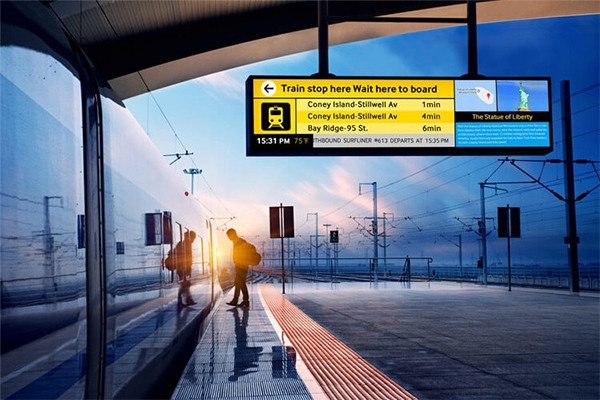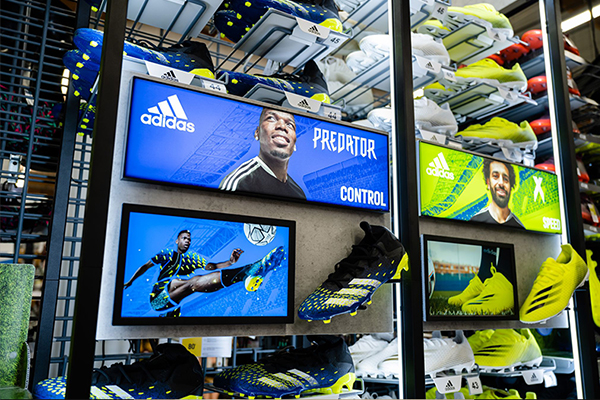Understanding Bar Type LCD Displays
Definition of Bar Type LCD Displays
Bar type LCD displays are elongated display panels characterized by their wide aspect ratio, which is suitable for showcasing content with panoramic views. These displays possess a rectangular shape, often with ultra-wide dimensions, making them an ideal choice for applications requiring extended visual real estate.
How do Bar Type LCD Displays Work?
Bar type LCD displays operate based on liquid crystal display (LCD) technology, where a backlight illuminates a layer of liquid crystals that selectively block or allow light to pass through. The liquid crystals are controlled electronically, forming images and text on the screen. Through this mechanism, bar type LCD displays deliver high-quality, vibrant visuals with sharp contrast and precise color reproduction.
Advantages of Bar Type LCD Displays
1. Wide Aspect Ratio
One of the primary advantages of bar type LCD displays is their wide aspect ratio. By providing an extensive horizontal view, these displays excel at presenting panoramic content, thereby enhancing the overall visual experience.
2. High Resolution and Image Quality
Bar type LCD displays boast high resolutions, allowing for crisp and detailed imagery. With the ability to showcase fine details accurately, these displays are well-suited for applications where image quality is paramount.
3. Space-saving design
The elongated shape of bar type LCD displays makes them space-efficient, especially in environments where limited installation space is a concern. Their streamlined design enables optimal utilization of available display areas without compromising functionality.
Applications of Bar Type LCD Displays
1. Transportation industry
Bar type LCD displays find extensive usage in the transportation industry, particularly for displaying relevant information in buses, trains, subways, and airports. Their wide aspect ratio is ideal for presenting schedules, advertisements, and passenger guidance, improving overall communication efficiency.
2. Digital signage
Due to their unique form factor, bar type LCD displays have become increasingly popular in digital signage applications. These displays effectively capture viewers' attention in various settings, such as retail stores, shopping malls, and outdoor advertising, enabling impactful brand promotion and message delivery.
3. Medical and healthcare
The medical and healthcare sectors leverage bar type LCD displays for multiple purposes. From patient monitoring and surgical displays to medical imaging and data visualization, these displays enable professionals to observe critical information with enhanced accuracy and precision.
4. Industrial automation
Bar type LCD displays play a crucial role in industrial automation environments. They facilitate real-time monitoring of complex processes, equipment status, and data visualization in manufacturing plants, control rooms, and other industrial settings. The extended width of these displays allows for comprehensive data representation and efficient decision-making.
5. Gaming and entertainment
In the gaming and entertainment industry, bar type LCD displays provide an immersive visual experience. Whether it's gaming interfaces or high-definition video walls in cinemas, their panoramic view enhances engagement and captivates audiences.
6. Other emerging applications
Bar type LCD displays are continuously finding new applications in emerging sectors. Examples include architectural displays for showcasing building designs, menu boards in restaurants, and dashboard displays in vehicles, where their unique shape and functionality offer innovative ways to convey information and engage users.

Types of Bar Type LCD Displays
A. TFT-LCD Displays
TFT-LCD (Thin-Film Transistor LCD) displays are a prevalent type of bar type LCD displays. They offer exceptional image quality, wide viewing angles, and high refresh rates, making them suitable for dynamic content. Their features include precise color reproduction, excellent contrast ratios, and fast response times.
B. OLED Displays
OLED (Organic Light-Emitting Diode) displays are another variant of bar type LCD displays. They operate without a backlight, as each pixel emits its own light. This technology enables OLED displays to achieve true blacks, vibrant colors, and infinite contrast ratios. With their thin and flexible nature, OLED bar type LCD displays open up new possibilities for curved and bendable form factors.
C. E-Paper Displays
E-Paper displays, also known as electronic paper displays, offer unique advantages in specific applications. They use electrophoretic technology, mimicking the appearance of ink on paper. E-Paper bar type LCD displays consume minimal power, provide excellent visibility under various lighting conditions, and retain images even when powered off. These characteristics make them ideal for applications such as e-readers, shelf labels, and other instances where low-power, static content is required.
Factors to Consider When Choosing Bar Type LCD Displays
Size and Aspect Ratio
Selecting the appropriate size and aspect ratio of a bar type LCD display is crucial for achieving the desired visual impact and fitting the intended installation space. Factors such as viewing distance, content requirements, and available mounting areas should be considered.
Resolution and Image Quality
Resolution determines the level of detail a bar type LCD display can showcase. Higher resolutions are preferable for applications where sharpness and clarity are vital, while lower resolutions may suffice for certain contexts. Additionally, considering image quality parameters like color accuracy, contrast ratio, and brightness ensures optimal visual performance.
Viewing Angle and Visibility
The viewing angle of a bar type LCD display affects how the content appears when viewed from different positions. Wide viewing angles are desirable to maintain consistent image quality for viewers located off-center. Additionally, considering factors like ambient lighting conditions, reflectiveness, and anti-glare properties enhances visibility in various environments.
Durability and Environmental Conditions
Depending on the application, selecting a bar type LCD display with suitable durability features is essential. Considerations include the display's resistance to dust, moisture, temperature fluctuations, and potential impacts. Ensuring compatibility with the intended operating environment optimizes performance and longevity.
Connectivity Options
Bar type LCD displays may require connectivity options such as HDMI, DisplayPort, or VGA for seamless integration with source devices. Assessing the compatibility of these options with existing equipment ensures smooth data transmission and content playback.
Touchscreen Capabilities
In applications where interactivity is desired, choosing a bar type LCD display with touchscreen functionality can enhance user engagement. Capacitive touchscreens, resistive touchscreens, and other technologies offer different levels of responsiveness and precision, depending on the requirements.
Cost and Budget Considerations
Bar type LCD displays vary in price based on their features, specifications, and manufacturers. Setting a budget and comparing different options helps select a display that balances functionality, quality, and cost-effectiveness.

Installation and Integration of Bar Type LCD Displays
Mounting Options and Mechanical Considerations
Determining the appropriate mounting method for a bar type LCD display is crucial for secure installation. Depending on the application and environment, options such as wall mounting, ceiling mounting, rack mounting, or freestanding solutions should be evaluated. Additionally, considering factors like weight, ergonomics, and maintenance accessibility simplifies the installation process.
Electrical Connections and Power Requirements
Understanding the electrical connections and power requirements of a bar type LCD display ensures seamless integration into existing systems. Evaluating voltage compatibility, power consumption, and cable management solutions simplifies setup and reduces potential issues.
Software and Driver Installation
Some bar type LCD displays require specific software or drivers for optimal functionality. Familiarizing oneself with installation processes, compatibility requirements, and necessary updates ensures a smooth setup and minimizes potential incompatibility issues.
Calibration and Fine-tuning
Calibrating a bar type LCD display is essential for achieving accurate color reproduction and optimal performance. Adjusting parameters such as color temperature, gamma correction, brightness, and contrast guarantees consistent visual quality and uniformity across the entire display.
Maintenance and Care Tips for Bar Type LCD Displays
Cleaning and Handling Guidelines
Following proper cleaning and handling guidelines helps maintain the longevity and visual quality of bar type LCD displays. Using non-abrasive materials, avoiding harsh chemicals, and adopting suitable cleaning practices prevent damage to the screen surface and other components.
Preventive Maintenance Practices
Implementing preventive maintenance practices ensures optimal performance and minimizes downtime. Regular inspections, software updates, and system checks help identify and address potential issues before they escalate, improving the overall reliability and lifespan of the display.
Troubleshooting Common Issues
Being familiar with common issues and their troubleshooting techniques enables swift resolution of any problems that may arise. Examples include addressing image distortion, dealing with connectivity issues, and resolving software-related glitches. Referring to the manufacturer's guidelines and support resources can be beneficial in such situations.
Future Trends and Developments in Bar Type LCD Displays
Advancements in Technology
The field of bar type LCD displays continues to evolve, with ongoing technological advancements opening up new possibilities. These developments include improvements in resolution, color gamut, contrast ratios, energy efficiency, and flexibility. Additionally, emerging technologies like mini-LED backlighting and micro-LED displays hold promise for enhancing the visual performance of bar type LCD displays.
Emerging Applications and Industries
As technology progresses, bar type LCD displays are finding applications in previously unexplored industries. Sectors such as education, hospitality, architecture, and security are recognizing the potential of these displays to deliver engaging and informative content in unique ways. The versatility and adaptability of bar type LCD displays make them well-suited for addressing evolving industry needs.
Market Forecast and Growth Opportunities
The market for bar type LCD displays is expected to experience significant growth in the coming years. With increasing demand for digital signage, transportation information systems, and immersive visual experiences, the adoption of bar type LCD displays is projected to expand across multiple industries. This growth presents opportunities for manufacturers, integrators, and businesses to capitalize on the advantages these displays offer.
Conclusion
Exploring the world of bar type LCD displays reveals their incredible potential in various industries. From transportation and digital signage to medical and gaming applications, these displays provide unique features such as wide aspect ratios, high resolutions, and space-saving designs. Choosing the right type of bar type LCD display involves considering factors like size, resolution, durability, connectivity options, and touchscreen capabilities. Installation, maintenance, and troubleshooting practices ensure optimal performance and longevity. Looking ahead, technological advancements and emerging applications indicate a promising future for bar type LCD displays.
Embrace the future of visual communication with Screenage and witness the transformative power they offer.
Post time: Oct-09-2023





